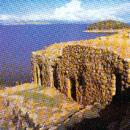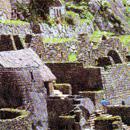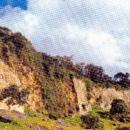Incas: Children of the Sun
When a traveler gets to the Andes, trapped between snow-capped peaks and seemingly endless tablelands stripped of lush vegetation and dotted by occasional adobe huts, or herds of alpacas and llamas, he catches the almost physical smell of ancientness that reeks of being the place where the world as we know it today was whipped into shape.
Maybe because they lived in a mountainous relieve way over 10,000 feet high, the Incas thought they had come from light. The word Inca, only used to name their chief or emperor, means child of the sun. Viracocha, the God of Creation, after sending down a raging downpour that killed off all giant creatures he'd made, allowed a couple to survive the flooding. From this couple, a new race was born. This time around, though, Viracocha kneaded them in clay as he'd done with the animals.
First of all, he made light. But the morning star wasn't as bright as the midnight sun. As Viracocha noted the jealousy of the sun, he tossed some cinders over the moon. That's the Inca version of the Genesis.
The legend justifies the alleged Inca concept –they spoke a non-written language called Quechua- of fate as a people. They thought to be better than the rest, handpicked human beings with a mission to conquest and rule their neighbors.
By 1450, the Incas (also known originally as the Capaccunas) submitted neighboring tribes of Chochapoyas, Chimus and other villages rendered as “savage” and doomed –they said- to live under the cracking whip of the children of the sun. Three hundred years after their God ordered Manco Capac and his sister Mama Ocllo to build Cuzco –the Incas were eventually told to move out to the Promised Land and build a mighty nation there- the empire had already spread from southern Colombia all the way to the Maule River in Chile, passing through territories in Ecuador, Peru and Bolivia. Geographically speaking, the Incas had taken the highest Andean peaks and a rainy jungle called Yunga, plus the deserts along the Pacific Coast, spanning a strip that runs 3,000 km from north to south and little more than 800 km from east to west.
Over 5 million aboriginals were logged in the Incas' imperial system. From Cuzco, the empire's capital, four roads led to the suyos, the four regions or portions that made up the empire. More than 3,000 miles of pebbled pathways and a system of chasquis (messengers who used to run a postal relay race every mile or so) kept the Incas posted on the latest developments.
But the Incas didn't found the only outstanding Andean civilization. For 3,200 years, the Tihuanacotas dwelt in the current territory of Bolivia. They came into being 2,000 years before the birth of Jesus Christ and faded out during their time of expansion.
Their disappearance still remains a mystery. How? Why? These are some of questions that historians and researchers keep asking themselves time and again. Author Antonio Paredes, while hawking his books at the La Paz Grove, told me this is a “mystery that will never be cleared out.” They just left behind some of their earthenware objects, silt carvings, a few mummies and the ceremonial site in a city called Tihuanacu, some 40 miles from La Paz and near the Titicaca Lake.
The traveler, standing atop a 3,845-meter-high tableland and pounded by chilly winds, gets jitters as he feasts his eyes on the solitude of these walls. Inside, monoliths of squared, unrelieved faces, together with solemn statues, seem to keep the secrets of that lost civilization for themselves. The Sun Gate, featuring a carved calendar over the dint, is a clear-cut proof that the Tihuanacotas mastered time circles, the same ones that perhaps one day, out of some kind of natural cataclysm, did them in for good.
All Andean peoples had their own traditions and spoke their own tongues. Inca emperors, however, rammed their laws and language down their throats. Ama sua, ama llulla, ama chekila (do not steal, so not lie, do not be lazy) were the three precepts that dominated their laws. They knew how to preserve corn and potatoes, peppers, tomatoes, papaya and charqui, and also mastered the preservation of llama meat. By the way, this camel-like animal served them to haul goods and merchandises around the heights.
Labor favored the Incas' imperial expansion. They waged war with bravery and industriousness, with their heads protected by feathered helmets. But they were better workers and rulers than warriors. Their labor chants used to cheer them up as if they were in the middle of a battle. Victory, Victory/Here, twisting the rope/Here's the labor/Here's the sweat/Here's the endeavor. On the other side of the field, another group of chanters was supposed to cry back: Work, men, work! A shortage of croplands forced them to build terraces or stonewalls filled with soil. If there was no water because God Thunder wasn't kind enough with them, then they used to bring it down from the heights by means of makeshift aqueducts.
Cuzco used to glitter under the sweltering sun. The walls of its one-to-two-story-high palaces were built using smooth stone slabs that the Incas plastered together almost seamlessly to a naked eye. The roofs were made of straw with interwoven threads of gold. The houses of the ordinary citizenry were built with stones, plastered in clay and painted. Drinkable water used to meander its way around the city through earthenware pipes. The population had toilets and bathrooms.
They also mastered the art of architecture. The ruins of the Machu Picchu, some kind of fortressed city next to Cuzco, is still standing to illustrate why both the life and works of the Incas were no doubt one of world's greatest civilizations of all time, a breed of Asian men that came to America from the north after crossing the Bering Strait some 40,000 years ago.
The Inca society and the subdued tribes used to lead an unvarying lifestyle ruled by collectivism and sealed by kinship. The empire used to foresee everything, from the right time of year to lean over the land and sow the seeds to the perfect timing for their children to get married. Marriage was mandatory and in case somebody couldn't find a mate, then the government provided him with a wife. Women's spare time –after doing all chores around the house and in the field- was mostly devoted to spinning and weaving wool.
After creating the Inca, Viracocha came down to earth to make sure his children would obey him. Nobody recognized him disguised as an old man who walked propped on a cane. The people stoned him because they took him for a foreigner.
And the God of Creation got in a rage and threw fire over the rocks. The population, afraid of dying, made a plea of forgiveness. A benign Viracocha stopped the suffering and the people built him a temple in Cuzco. The God said good-bye and headed for the north walking on water into the Pacific Ocean. In 1525, the white man showed up, lined up in Pizarro's army. The terrible news made the rounds as chasquis ran frenziedly from one side to the other: “Viracocha is back!” they said.
The last day of the rest of their lives has just begun.




































































